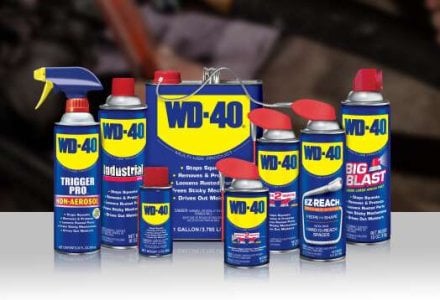Are You Misusing WD-40? Find Out Now!
Ever found yourself in a sticky, squeaky, or rusty situation? If so, it's likely a knight in shining (or shall we say, shiny blue) armour—WD-40, came to your rescue.
Over the years, this 'can of wonder' has saved many a squeaky door hinge, kept rust off our trusty garden tools, and made removing grimy residue from stickers a breeze.
But in all its glory, remember, the magic of WD-40 isn't without its limits. There are many places where this product is not suited. So let’s dive into these ‘no-go’ zones for WD-40.

Polystyrene in disposable items and clear plastics like polycarbonate, used in safety gear, can react adversely to WD-40.
The lubricant could dissolve the protective wax finish and seep into the grain of unfinished wood, destroying your beloved furniture.
The reality, though, is a twisted fairy tale. Like a sponge in water, natural stone can become stained from the absorbed WD-40, shattering your cleaning dreams (not to mention the wax finishes that can dissolve under WD-40’s influence).
You might be tempted to give those stainless steel appliances a glossy WD-40 shine. But unless you fancy ingesting WD-40 residues along with your dinner, avoid spraying it on surfaces where food meets metal. No sparkle is worth a trip to the emergency room!
But using it on your smartphone or laptop might not yield the shiny outcome you hope for. Certain plastics used in electronic devices can weaken, it might attract dust particles, and the consequences can be expensive!

In conclusion, dear friends, WD-40 is no doubt a lifesaver in many situations. But it's essential to know when this product performs miracles and when it can cause catastrophe.
So next time you're reaching for that blue spray, do a quick mental rundown of these guidelines.
Have you mistakenly used WD-40 on surfaces like plastic, woodwork, natural stone, kitchen surfaces or electronics? Alternatively, are there any other places you know that WD-40 should not be applied to? Let us know in the comments section down below.
Over the years, this 'can of wonder' has saved many a squeaky door hinge, kept rust off our trusty garden tools, and made removing grimy residue from stickers a breeze.
But in all its glory, remember, the magic of WD-40 isn't without its limits. There are many places where this product is not suited. So let’s dive into these ‘no-go’ zones for WD-40.

One interesting fact about WD-40 is that its name stands for ‘Water Displacement, 40th Formula’. It was the 40th attempt by the chemists to create a water displacement solution, which eventually became the multi-purpose lubricant and solvent known as WD-40. Source: WD-40
Plastic
First up on our caution list—plastic! It’s a common misunderstanding that WD-40 is safe on all plastics. Unless you cherish the thought of your sunnies disintegrating in the hot Aussie sun, putting that can down is best.Polystyrene in disposable items and clear plastics like polycarbonate, used in safety gear, can react adversely to WD-40.
Woodwork
Fancy giving that patio chair a WD-40 makeover? Hold your horses! WD-40 against wooden surfaces is akin to an alien invasion.The lubricant could dissolve the protective wax finish and seep into the grain of unfinished wood, destroying your beloved furniture.
Natural Stone
Next on our list is natural stone. Lured by WD-40's cleaning prowess, you might think it's safe to give them a thorough scrub.The reality, though, is a twisted fairy tale. Like a sponge in water, natural stone can become stained from the absorbed WD-40, shattering your cleaning dreams (not to mention the wax finishes that can dissolve under WD-40’s influence).
Kitchen
Next, the heart of your home—the kitchen.You might be tempted to give those stainless steel appliances a glossy WD-40 shine. But unless you fancy ingesting WD-40 residues along with your dinner, avoid spraying it on surfaces where food meets metal. No sparkle is worth a trip to the emergency room!
Electronics
Cruising along the WD-40 sensitive territory, we now venture into the world of electronics. Sure, that stubborn grime on the laptop is testing your patience, and WD-40 has historically been your cleaning hero.But using it on your smartphone or laptop might not yield the shiny outcome you hope for. Certain plastics used in electronic devices can weaken, it might attract dust particles, and the consequences can be expensive!
Key Takeaways
- WD-40, while versatile, should not be used on certain surfaces, such as plastic, woodwork, natural stone and anywhere food is prepared.
- The chemical makeup of WD-40 can cause damage to clear plastic surfaces, polystyrene or polycarbonate plastic items, potentially ruining these tools or appliances.
- WD-40 has the ability to dissolve wax finishes and seep into the grains of unfinished wood. It should be avoided on wooden surfaces and furniture.
- Despite its wide usage in cleaning tasks, WD-40 should not be used on surfaces that come in contact with food and on electronics.
In conclusion, dear friends, WD-40 is no doubt a lifesaver in many situations. But it's essential to know when this product performs miracles and when it can cause catastrophe.
So next time you're reaching for that blue spray, do a quick mental rundown of these guidelines.
Have you mistakenly used WD-40 on surfaces like plastic, woodwork, natural stone, kitchen surfaces or electronics? Alternatively, are there any other places you know that WD-40 should not be applied to? Let us know in the comments section down below.







